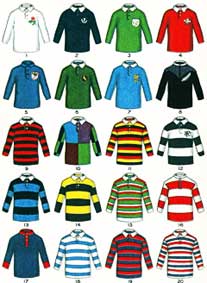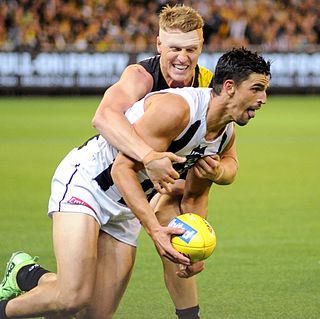
Most forms of football have a move known as a tackle. The primary purposes of tackling are to dispossess an opponent of the ball, to stop the player from gaining ground towards goal or to stop them from carrying out what they intend.

Rugby football is the collective name for the team sports of rugby union or rugby league.

Rugby union football, commonly known simply as rugby union or often just rugby, is a close-contact team sport that originated at Rugby School in England in the first half of the 19th century. Rugby is based on running with the ball in hand. In its most common form, a game is played between two teams of 15 players each, using an oval-shaped ball on a rectangular field called a pitch. The field has H-shaped goalposts at both ends.
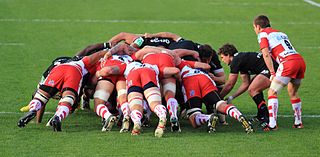
A scrummage, commonly known simply as a scrum, is a method of restarting play in rugby football that involves players packing closely together with their heads down and attempting to gain possession of the ball. Depending on whether it is in rugby union or rugby league, the scrum is used either after an accidental infringement or when the ball has gone out of play. Scrums occur more often, and are now of greater importance, in union than in league. Starting play from the line of scrimmage in gridiron football is derived from the scrum.
In rugby football, the penalty is the main disciplinary sanction available to the referee to penalise players who commit deliberate infringements. The team who did not commit the infringement are given possession of the ball and may either kick it towards touch, attempt a place kick at goal, or tap the ball with their foot and run it. It is also sometimes used as shorthand for penalty goal.

Sports equipment, also called sporting goods, are the tools, materials, apparel, and gear, which varies in shapes, size, and usage in a particular sport. It includes balls, nets, rackets, protective gears like helmets, goggles, etc. Since the performer must use a sport equipment, it can also be serve for protection.

Touch rugby refers to games derived from rugby league in which players do not tackle each other but instead touch their opponents using their hands on any part of the body, clothing, or the ball.
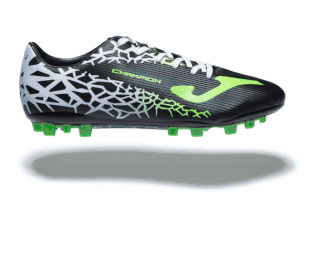
Football boots, also known as cleats or soccer shoes in North American English, are a type of shoe worn when playing association football (soccer), most of its variations, and some games that are played on the same surface. Those designed for grass pitches have studs on the outsole to aid grip. Modern "boots" are no longer truly traditional boots in that they do not cover the ankle — like most other types of athletic footwear, their basic design and appearance have converged with that of sneakers since the 1960s.

In association football, kit is the standard equipment and attire worn by players. The sport's rules specify the minimum kit which a player must use, and also prohibit the use of anything that is dangerous to either the player or another participant. Individual competitions may stipulate further restrictions, such as regulating the size of logos displayed on shirts and stating that, in the event of a match between teams with identical or similar colours, the away team must change to different coloured attire, to avoid clashes.

A comparison of American football and rugby union is possible because of the games' shared origins, despite their dissimilarities.

Rugby union is a contact sport that consists of two teams of fifteen players. The objective is to obtain more points than the opposition through scoring tries or kicking goals over eighty minutes of playing time. The play is started with one team drop-kicking the ball from the halfway line towards the opposition. The rugby ball can be moved up the field by either carrying it or kicking it. However, when passing the ball it can only be thrown laterally or backward. The opposition can stop players moving up the field by tackling them. Only players carrying the ball can be tackled and once a tackle is completed the opposition can compete for the ball. Play continues until a try is scored, the ball crosses the side line or dead-ball line, or an infringement occurs. After a team scores points, the non-scoring team restarts the game at the halfway with a drop kick toward the opposition. The team with the most points at the end wins the game.

Cleats or studs are protrusions on the sole of a shoe or on an external attachment to a shoe that provide additional traction on a soft or slippery surface. They can be conical or blade-like in shape and can be made of plastic, rubber or metal. The type worn depends on the environment of play: grass, ice, artificial turf, or other grounds.
This is a general glossary of the terminology used in the sport of rugby union. Where words in a sentence are also defined elsewhere in this article, they appear in italics.

In rugby union a scrum is a means of restarting play after a minor infringement. It involves up to eight players from each team, known as the pack or forward pack, binding together in three rows and interlocking with the three opposing teams front row. At this point the ball is fed into the gap between the two forward packs and they both compete for the ball to win possession. Teams can be penalised for intentionally causing the scrum to collapse, and for not putting the ball into the scrum correctly. A scrum is most commonly awarded when the ball is knocked forward, or passed forward, or when a ball becomes trapped in a ruck or maul. Because of the physical nature of scrums, injuries can occur, especially in the front row.

The scrum cap is a form of headgear used by rugby players to protect the ears in the scrum, which can otherwise suffer injuries leading to the condition commonly known as cauliflower ears. Although originally designed for forwards they are now worn by players of all positions, even those who do not play in the scrum.
Mini rugby, also known as New Image Rugby, is a form of rugby union designed to introduce the sport to children. It uses a smaller ball and pitch than standard rugby, and has eight to ten players a side.
A comparison of Canadian football and rugby union is possible because of the games' shared origins, despite their dissimilarities.

Rugby union match officials are responsible for enforcing the laws of rugby union during a match. "Every match is under the control of match officials who consist of the referee and two touch judges or assistant referees." Further officials can be authorised depending on the level and form of the game.
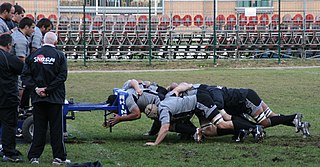
A scrum machine, or scrummaging machine, is a padded, weighty device against which a pack of rugby forwards can practice scrummaging and rucking. The purpose of the scrum machine is to provide teams with a safe tool with which to improve the strength and skills of their players.

The laws of Rugby Union are defined by World Rugby and dictate how the game should be played. They are enforced by a referee, generally with the help of two assistant referees.
